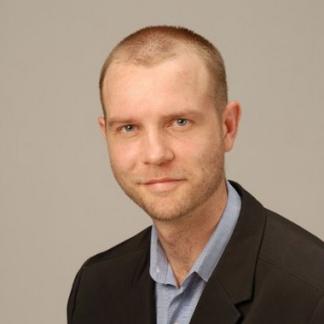Johannes Burge
3710 Hamilton Walk
Goddard Lab, Room 426

Sensation and Perception
Specific Research Areas
Computational Models of Visual Processing; Depth Perception; Human Vision; Task-Specific Natural Scene Statistics; Visual Neuroscience
Estimating the speed of a passing object; estimating the distance between two objects in a scene far two objects are far each other; refocusing your eye from near to far… You perform these tasks more than 100,000 times per day. But the effortlessness with which you perform these tasks belies enormous computational complexity. Our work concentrates on understanding how to estimate depth from natural images. We determine how best to estimate individual depth cues from natural images (e.g. defocus, disparity, motion), and we use behavioral studies to investigate how well humans estimate those same cues.
A fundamental goal of vision research is to understand how vision functions in natural conditions with natural stimuli. How do we see? What are the computations that optimally transform sensory information into behaviorally relevant representations of the environment? What are the computations that humans and animals actually use? Unfortunately, natural stimuli are monstrously complicated and are difficult to characterize mathematically. As a result, most vision research uses simple, artificial stimuli that are easier to characterize (e.g. bars and blobs). Most of our knowledge about visual processing derives from research with such stimuli; however, they lack many of the properties inherent to natural stimuli, the stimuli the visual system evolved to process.
The primary aim of my research is to enable the principled study of critical visual tasks with natural stimuli. Rather than attempting to develop a general model natural stimuli, we narrow the problem by focusing on the properties of natural stimuli that are most useful for particular tasks. We develop tools to enable rigorous mathematical characterization of the task-relevant properties of natural stimuli. These tools help generate principled, quantitative hypotheses about how visual information should be processed ideally. These hypotheses are then used to make predictions about and design experiments to test behavioral performance and neural processing. In some cases, we have discovered a striking correspondence between an ideal and the human visual system. Methods that are developed for the study of a given task in the human visual system can oftentimes be applied to a similar task in animal or machine vision systems.
PSYC 1340: Perception
PSYC 4340: Research Experience in Perception
PSYC 6000: Proseminar in Perception
Advisee
Callista Dyer [Psychology Graduate Student]
Burge J, Rodriguez-Lopez V, Dorronsoro C (2019). Monovision and the misperception of motion.
Current Biology, 29, 2586-2592, doi: https://doi.org/10.1016/j.cub.2019.06.070 [ html1 | html2 ]
Iyer A, Burge J (2018). Depth variation and stereo processing tasks in natural scenes. Journal of Vision, 18(6):4, 1-22 [ html | pdf ]
Kim S, Burge J (2018). The lawful imprecision of human surface tilt estimation in natural scenes. eLife, 7:e31148, doi:https://doi.org/10.7554/eLife.31448 [ html | pdf ]
Jaini P, Burge J (2017). Linking normative models of natural tasks with descriptive models of neural response. Journal of Vision, 17(12):16, 1-26 [ html | pdf ]
Burge J, Jaini P (2017). Accuracy Maximization Analysis for sensory-perceptual tasks: Computational improvements, filter robustness, and coding advantages for scaled additive noise. PLoS Computational Biology, 13(2): e1005281. doi:10.1371/journal.pcbi.1005281 [ html | pdf ]
Burge J, Mccann BC, Geisler WS (2016). Estimating 3D tilt from local image cues in natural scenes. Journal of Vision 16: 13, 1-25 doi:10.1167/16.13.2 [ html | pdf ]
Green JD, Burge J, Stansberry JA, Meinke B (2016). Cameras a Million Miles Apart: Stereoscopic Imaging Potential with the Hubble and James Webb Space Telescopes. arXiv:1610.0748 [ html | pdf ]
Burge J, Geisler WS (2015). Optimal speed estimation in natural image movies predicts human performance. Nature Communications,6: 7900, 1-11 doi:10.1038/ncomms8900 [ html | pdf ]
Bonnen K, Burge J, Yates J, Pillow JW, Cormack LK (2015). Continuous psychophysics: Target-tracking to measure visual sensitivity. Journal of Vision 15(3):14, 1-16 [ html | pdf ]
Burge J, Geisler WS (2014). Optimal disparity estimation in natural stereo-images. Journal of Vision, 14:2(1), 1-18 [ html | pdf ]
Burge J & Geisler WS (2011). Optimal defocus estimation in individual natural images. Proceedings of the National Academy of Sciences, 108 (40): 16849-16854 [ pdf ]
Burge J, Fowlkes CC, Banks MS (2010). Natural scene statistics predict how the figure-ground cue of convexity affects human depth perception.Journal of Neuroscience, 30(21): 7269-7280. [ pdf | supp ]
Burge J, Ernst MO, Banks MS (2008). The statistical determinants of adaptation rate in human reaching.Journal of Vision, 8(4) 20: 1-19. [ pdf ]